Namsan (Seoul)
Namsan (Korean: 남산; lit. South Mountain), officially Namsan Mountain, is a 270-meter (890 ft)-high peak in Jung-gu, Seoul, South Korea. Although known as Mongmyeoksan, or 목멱산 / 木覓山 in the past, it is now commonly referred to as Mt. Namsan. It offers some hiking, picnic areas and views of downtown Seoul's skyline. The N Seoul Tower is located on top of Mt. Namsan.
| Namsan | |
|---|---|
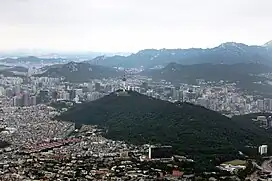 | |
| Highest point | |
| Elevation | 270 m (890 ft) |
| Coordinates | 37°32′59″N 126°59′31″E |
| Geography | |
 Namsan Jung-gu, Seoul, South Korea 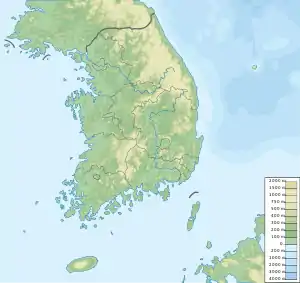 Namsan Namsan (South Korea) | |
| Namsan | |
| Hangul | |
|---|---|
| Hanja | |
| Revised Romanization | Namsan |
| McCune–Reischauer | Namsan |
The mountain and its surrounding area is Namsan Park, a public park maintained by the city government, which has panoramic views of Seoul. It is also the location of a smoke signal station called Mongmyeoksan Beacon Tower (목멱산 봉수대; Mongmyeoksan Bongsudae), which was part of an emergency communication system during much of Seoul's history until 1985. From 1925 to 1945 the Shinto shrine known as Chōsen Shrine was situated on Mt. Namsan.[1]
In 2011, a survey was conducted by Seoul Development Institute, which included 800 residents and 103 urban planners and architects. It ranked Mt. Namsan as the most scenic location in Seoul by 62.8 percent of residents and 70.9 percent of the experts surveyed.[2]
The park and the fountain were used as the filming location for Seoul Broadcasting System (SBS)'s drama Lovers in Paris.[3]
Namsan is mentioned in the second verse of South Korea's National Anthem.
Tourist attractions
- N Seoul Tower: N Seoul Tower's height reaches 480 meters (1,570 ft) above sea level, and it sits in the 90 square meters (970 sq ft) of Mt. Namsan So.
- Namsangol Hanok Village: Seoul restored 24,180 acres of terrain which had been damaged for a long time and rejuvenated the traditional garden, and relocated and restored five Traditional Hanok buildings.
- Namsan cable car: It was the first cable car facility in Korea. It was first opened on 12 May 1962, and is the longest-running cable car in Korea that has run without a day's rest.
Gallery
.jpg.webp) View of the former Chōsen Shrine on top of the mountain (c. 1920s)
View of the former Chōsen Shrine on top of the mountain (c. 1920s)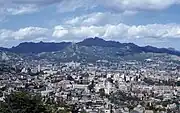 View from the mountain, facing north (1953)
View from the mountain, facing north (1953).jpg.webp) The mountain at dusk (2014)
The mountain at dusk (2014)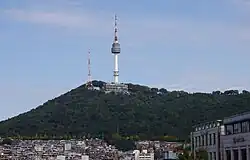 The mountain (2018)
The mountain (2018)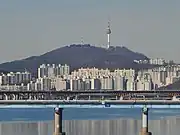 The mountain from the south bank of the Han River (2022)
The mountain from the south bank of the Han River (2022)
References
- Wakabayashi, Ippei. "Ahn Jung-geun and the Cultural Public Sphere" (PDF). Bunkyo University. Archived from the original (PDF) on 13 June 2011. Retrieved 31 March 2011.
- "Mt. Nam Picked as Seoul's No. 1 Scenic Attraction". Chosun Ilbo. 28 April 2011. Retrieved 4 June 2012.
- "Korean TV Drama: Lovers in Paris". Korea Tourism Organization. Retrieved 16 June 2012.
External links